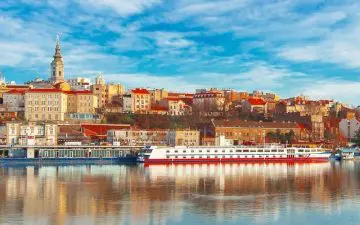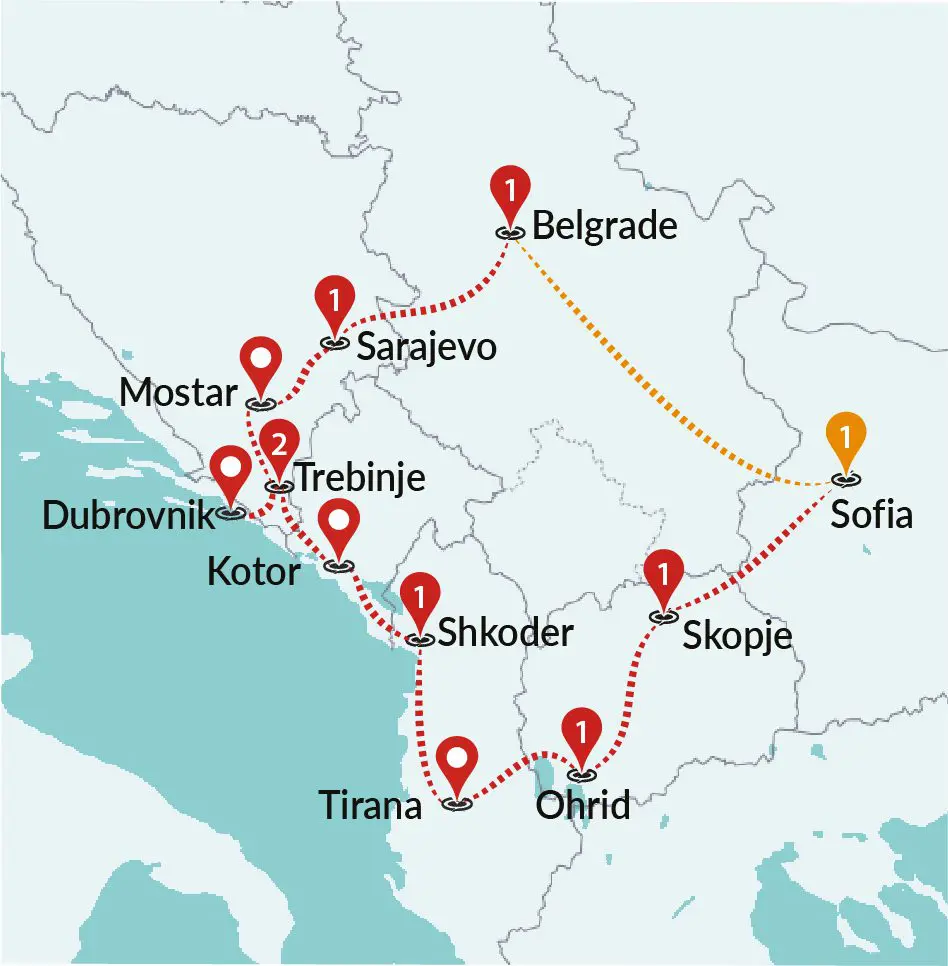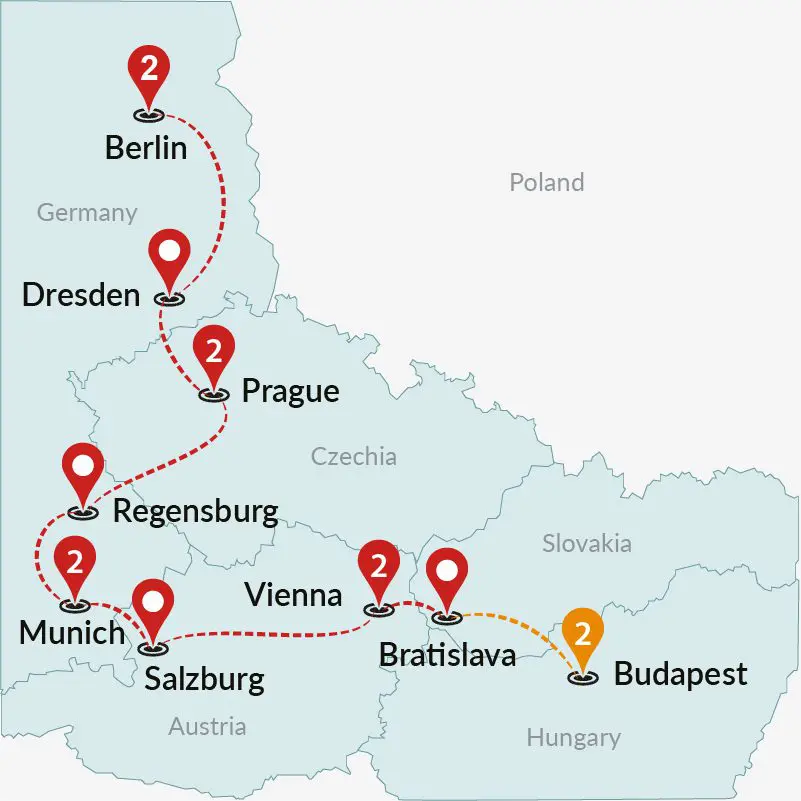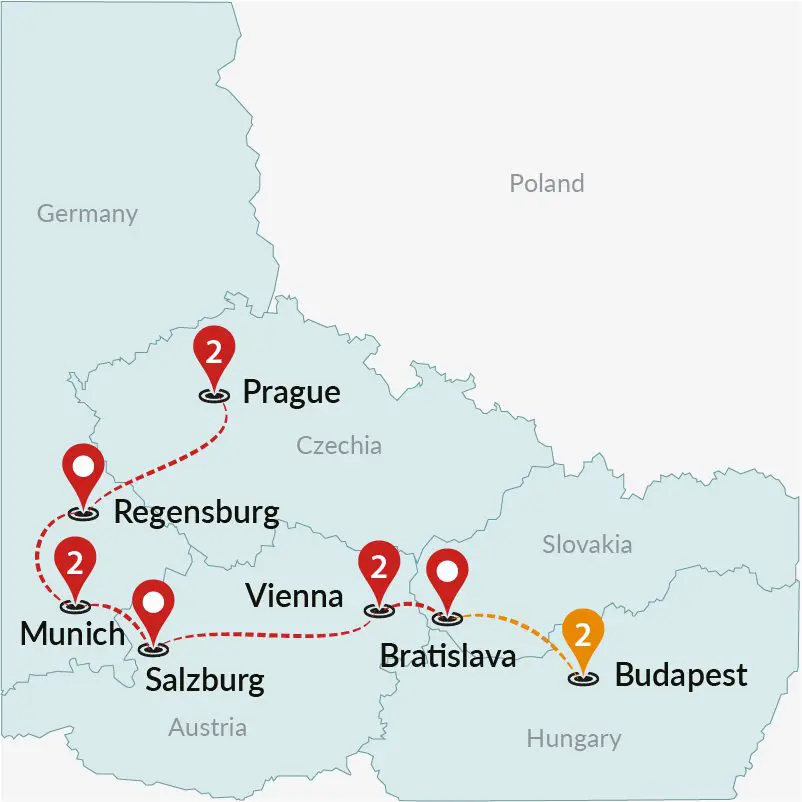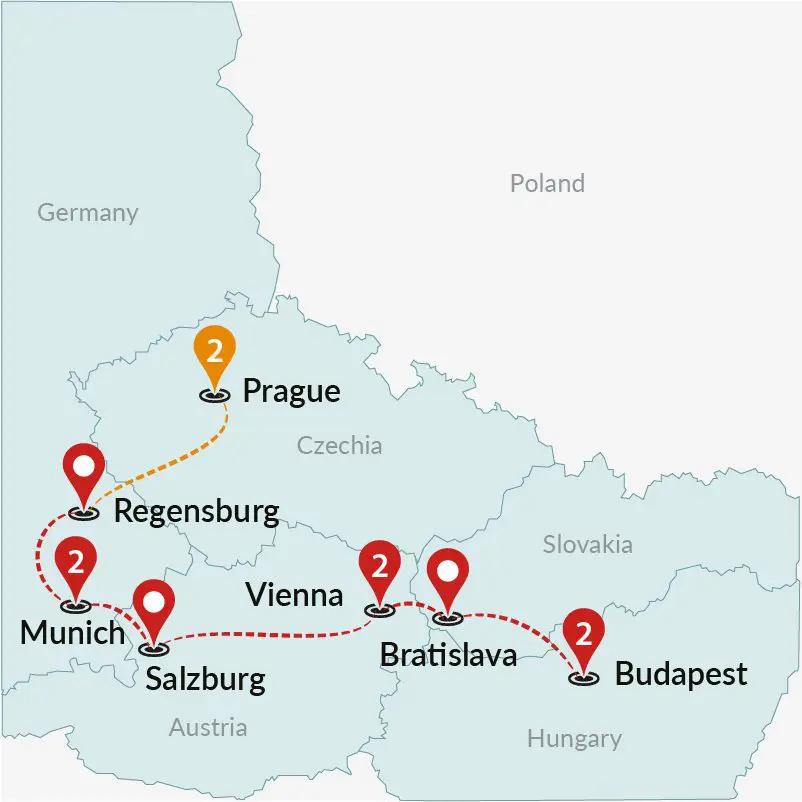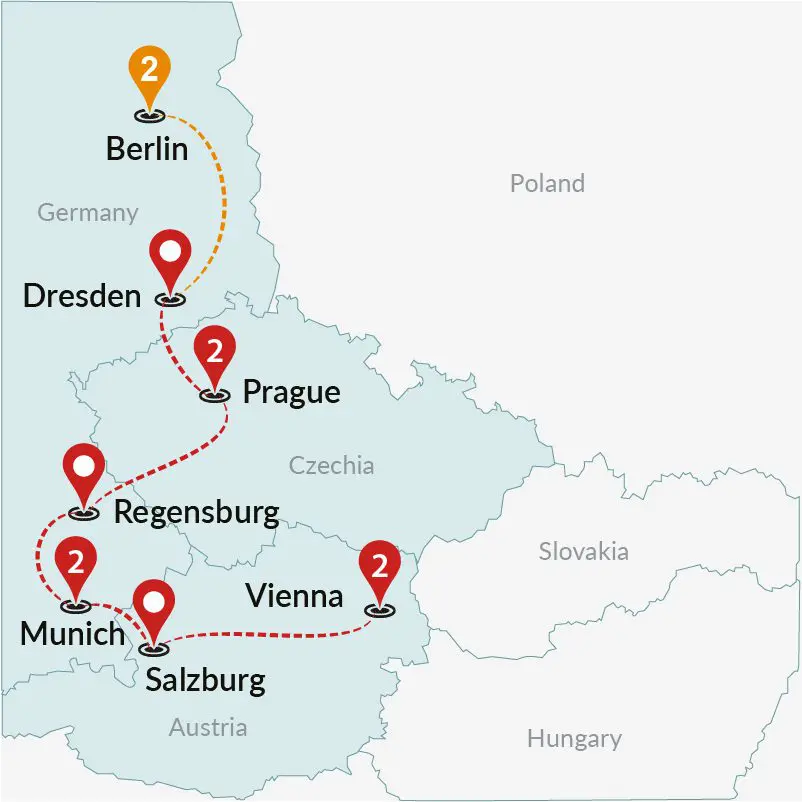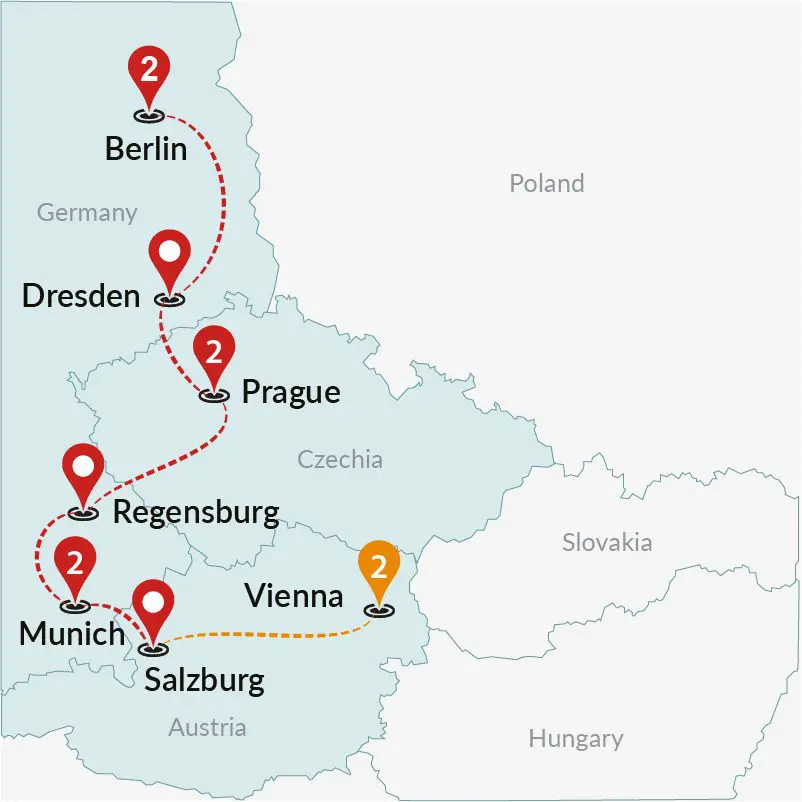Best Time To Visit Central Europe
The best time to visit Central Europe is generally during the spring (April to June) and fall (September to October) months. During these periods, the weather is typically mild and pleasant, making it ideal for exploring the charming cities and picturesque landscapes that define the region. Spring brings blooming flowers and vibrant greenery, while fall showcases stunning autumn colors.
Summer (July and August) can also be a good time to visit, as temperatures are warmer, and outdoor events and festivals are in full swing. However, this is also the peak tourist season, so popular destinations may be crowded.
Winter (December to February) offers a magical experience with festive markets and the chance to enjoy winter sports in the Alpine regions, but the cold weather may limit some outdoor activities. Ultimately, the best time to visit Central Europe depends on personal preferences, with each season offering unique experiences and atmospheres.
Why You Should Visit Central Europe: Visiting Central Europe is a captivating experience that offers a rich tapestry of history, culture, and natural beauty. The region boasts a collection of charming cities such as Prague, Budapest, Vienna, and Krakow, each with its own unique architecture, vibrant arts scene, and delicious cuisine. Central Europe is a treasure trove of historical landmarks, including medieval castles, Gothic cathedrals, and well-preserved old towns that transport visitors back in time.
Things to Consider: When planning a visit to Central Europe, consider the seasonal weather, as each season offers a different experience. Be mindful of peak tourist seasons to avoid crowds and high prices. Check for cultural events and festivals happening during your stay to immerse yourself in local traditions.
Monthly Travel Guide For Central Europe
Travelling in Central Europe in April and May
Traveling to Central Europe from April to May marks the transition from winter to spring, offering a more pleasant and varied climate. During this period, temperatures start to rise, and you can expect milder and more comfortable weather.
In April, temperatures may still be cool, especially earlier in the month, with occasional rain showers. As May approaches, the weather tends to become warmer, and you’ll likely experience more sunshine.

Central Europe Climate & Weather Guide
| Region | Jan | Feb | Mar | Apr | May | Jun | Jul | Aug | Sep | Oct | Nov | Dec | |
|---|---|---|---|---|---|---|---|---|---|---|---|---|---|
| Bucharest | 12 km/h | 13 km/h | 13 km/h | 12 km/h | 11 km/h | 9 km/h | 9 km/h | 10 km/h | 11 km/h | 11 km/h | 11 km/h | 11 km/h | |
| Brasov | 7 km/h | 7 km/h | 8 km/h | 9 km/h | 8 km/h | 7 km/h | 7 km/h | 6 km/h | 8 km/h | 7 km/h | 7 km/h | 7 km/h | |
| Cluj-Napoca | 7 km/h | 8 km/h | 8 km/h | 8 km/h | 8 km/h | 7 km/h | 7 km/h | 6 km/h | 7 km/h | 7 km/h | 6 km/h | 7 km/h | |
| Sibiu | 6 km/h | 7 km/h | 7 km/h | 7 km/h | 6 km/h | 6 km/h | 6 km/h | 5 km/h | 6 km/h | 6 km/h | 6 km/h | 6 km/h | |
| Ruse | 12 km/h | 13 km/h | 13 km/h | 12 km/h | 11 km/h | 10 km/h | 9 km/h | 10 km/h | 11 km/h | 11 km/h | 11 km/h | 12 km/h | |
| Plovdiv | 7 km/h | 8 km/h | 8 km/h | 8 km/h | 8 km/h | 8 km/h | 8 km/h | 8 km/h | 7 km/h | 7 km/h | 7 km/h | 7 km/h | |
| Sofia | 8 km/h | 9 km/h | 9 km/h | 8 km/h | 8 km/h | 7 km/h | 7 km/h | 7 km/h | 7 km/h | 7 km/h | 7 km/h | 8 km/h |
When to visit Central Europe
Trips to Central Europe in Spring and Fall
Trips to Central Europe in spring (April to June) and fall (September to October) offer travelers an enchanting blend of favorable weather, cultural richness, and diverse landscapes. In spring, the region awakens with blooming flowers and vibrant greenery, creating a picturesque backdrop for exploration. The mild temperatures during this period are ideal for strolling through charming cities, enjoying outdoor activities, and witnessing the renewal of nature.
Spring is also a time for various cultural events and festivals, providing a unique opportunity to immerse oneself in local traditions. Similarly, fall in Central Europe brings stunning autumn colors, creating a tapestry of reds, yellows, and browns. The crisp air and milder temperatures make it an excellent time for scenic hikes, exploring historic sites, and attending harvest festivals. Both seasons offer a more relaxed atmosphere compared to the bustling summer months, allowing travelers to savor the beauty and cultural treasures of Central Europe in a more serene setting.
Tips for visiting Central Europe in the spring and fall:
– For a trip to Central Europe in spring and fall, pack clothing layers to adapt to changing temperatures, and choose comfortable footwear suitable for various activities.
– Check local festival schedules and book accommodations in advance to align your visit with cultural events, ensuring a more enriching experience and securing comfortable lodging.
– Take advantage of mild weather to engage in outdoor activities like hiking and exploring parks.
Central Europe in Summer
Central Europe in summer is a vibrant tapestry of bustling cities, lush landscapes, and a myriad of cultural festivities. From June to August, the region experiences warm temperatures, making it an ideal time for outdoor exploration and leisurely strolls through charming streets. Cities like Prague, Vienna, and Budapest come alive with outdoor cafes, lively markets, and cultural events. The Alpine regions offer a playground for hiking and adventure enthusiasts, while the serene lakes and rivers provide opportunities for relaxation.
Summer also marks the peak of the tourist season, with countless festivals celebrating music, arts, and local traditions. Whether you’re wandering through historic cobblestone streets, exploring medieval castles, or enjoying the picturesque landscapes, Central Europe in summer captivates with its diverse offerings, creating lasting memories for travelers.
Why you should take a trip to Central Europe in the summer:
– Taking a trip to Central Europe in the summer is an enticing prospect for several compelling reasons.
– The region comes alive with a vibrant energy as warm temperatures create an inviting atmosphere for exploration.
– From the charming streets of historic cities to the breathtaking landscapes of the Alps, summer allows visitors to fully enjoy outdoor activities, whether it’s hiking, biking, or simply strolling through picturesque parks.
– The long days provide ample time to explore cultural attractions, attend open-air concerts, and immerse yourself in local festivals.
Central Europe FAQ
What’s the best time to visit Central Europe for budget travellers?
The best time for budget travelers to visit Central Europe is typically during the shoulder seasons, which fall between the peak tourist periods of summer and winter. Spring (April to June) and autumn (September to October) offer pleasant weather, fewer crowds, and lower accommodation prices. During these months, you can explore popular destinations like Prague, Budapest, and Vienna without the peak-season prices.
What is the hottest month in Central Europe?
The hottest month in Central Europe is generally July. During this time, countries like Germany, Austria, Czech Republic, Hungary, and Poland experience their peak summer temperatures. Cities such as Vienna, Budapest, and Prague can see daytime temperatures reaching well above 30 degrees Celsius (86 degrees Fahrenheit) during July. Travelers planning a visit during this period should be prepared for warm weather and may want to explore outdoor attractions and activities early in the day or during the cooler evenings.
What is the best month to visit Central Europe to beat the crowds?
The best months to visit Romania to beat the crowds are generally April to June and September to November. These months fall outside of the peak summer travel season when many tourists flock to Romania to enjoy the warm weather and outdoor activities.
During the shoulder season, the crowds are thinner, and you’ll have a better chance of avoiding long lines and crowded tourist attractions.
When is the best time to experience Central European culture?
The best time to experience Central European culture is during the spring and summer months, from April to September. This period offers a vibrant atmosphere with numerous cultural events, festivals, and outdoor activities taking place across the region. Cities like Vienna, Prague, Budapest, and Krakow come alive with concerts, art exhibitions, and traditional celebrations during these warmer months. Outdoor markets, street performances, and open-air events provide a rich cultural experience, allowing travelers to immerse themselves in the local traditions, cuisine, and arts.
What is the best season to visit Central Europe?
The best season to visit Central Europe depends on personal preferences and the type of experience you seek. Generally, late spring (May to June) and early autumn (September to October) are considered the best seasons. During these times, the weather is mild, and there are fewer tourists, allowing for a more pleasant and relaxed experience. Spring brings blooming flowers and green landscapes, while autumn showcases beautiful fall colors. Summer (July and August) is also popular, offering warm temperatures and a lively atmosphere, but it can be more crowded and some areas may experience higher prices.
When is the best time to taste Central Europe food?
The best time to taste Central European food is during the fall and winter months, particularly from September to December. This period aligns with the harvest season, bringing an abundance of fresh, locally sourced ingredients that enhance the flavors of traditional dishes. Fall is known for hearty stews, root vegetables, and game meats, while winter brings festive markets with seasonal treats like mulled wine, gingerbread, and various holiday specialties.
How many days do you need to visit Central Europe?
The ideal duration for a visit to Central Europe depends on the specific countries and cities you plan to explore, as well as your travel preferences. A well-rounded trip covering major destinations like Prague, Vienna, Budapest, and Krakow would typically require around 10 to 14 days to allow for a comfortable exploration of each city and its surrounding attractions.
What is the coldest month in Central Europe?
The coldest month in Central Europe is typically January. During this month, countries like Germany, Austria, Czech Republic, Hungary, and Poland experience winter temperatures at their lowest. Cities such as Vienna, Prague, Budapest, and Warsaw can have sub-zero temperatures, and snowfall is common in many regions.
What are the best cities to visit in Central Europe?
Central Europe offers a tapestry of enchanting cities, each with its distinctive charm. Prague, with its fairy-tale-like architecture, Vienna’s imperial grandeur, and Budapest’s scenic Danube River setting are highlights. Krakow, steeped in history, boasts a well-preserved Old Town, while Berlin’s cosmopolitan energy and iconic landmarks captivate visitors. Bratislava on the Danube, Ljubljana’s quaint charm against the Julian Alps, and the emerging allure of Zagreb in Croatia contribute to the region’s richness.
Is it safe to travel to Central Europe?
Central Europe is generally considered a safe destination for travelers. Countries like Germany, Austria, Czech Republic, Hungary, Poland, and others have well-developed tourism infrastructure and are known for their safety and hospitality.
What are the most beautiful places in Central Europe?
Central Europe boasts a collection of incredibly beautiful destinations that blend historical charm with natural wonders. The alpine village of Hallstatt in Austria, with its lakeside setting and picturesque architecture, stands out as a fairy-tale gem. Cesky Krumlov in the Czech Republic captivates with its medieval old town and Vltava River views. Plitvice Lakes National Park in Croatia offers a mesmerizing tableau of cascading lakes and lush greenery. The Wachau Valley along the Danube River in Austria enchants with vineyards, villages, and castles. The High Tatras, straddling Slovakia and Poland, provide a haven of alpine beauty.
Does Central Europe have nightlife?
Central Europe boasts a lively and diverse nightlife across its major cities. Prague in the Czech Republic is known for its bustling nightlife districts like Zizkov and Vinohrady. Budapest, Hungary, offers unique experiences with ruin bars, thermal bath parties, and vibrant clubs in District VII. Berlin, Germany, stands out for its 24/7 nightlife, eclectic clubs, and diverse music scenes. Vienna, Austria, surprises with contemporary nightlife in the MuseumsQuartier and Gürtel areas.
Which airlines fly directly into Central Europe?
Lufthansa: Germany’s flagship carrier, Lufthansa, provides extensive service to many Central European destinations, including Frankfurt and Munich as major hubs.
Austrian Airlines: As the national carrier of Austria, Austrian Airlines connects Central European cities, with Vienna serving as a primary hub.
LOT Polish Airlines: LOT is the flag carrier of Poland, operating direct flights to cities such as Warsaw and Krakow.
Czech Airlines (CSA): The national carrier of the Czech Republic, CSA, operates flights to Prague from various international locations.
What to wear in Central Europe?
When visiting Central Europe, especially in the cooler months, it’s advisable to pack layered clothing, including a mix of sweaters, jackets, and waterproof outerwear. Comfortable walking shoes are essential for exploring cities and historical sites. In the summer, lightweight clothing is suitable, but it’s wise to have a light jacket or sweater for cooler evenings. Check the weather forecast for your specific travel dates and pack accordingly. In churches and certain attractions, modest clothing may be required, so having a shawl or scarf is handy.
What is Central Europe famous for?
Central Europe is famous for its rich history, stunning architecture, and cultural heritage. The region is home to picturesque cities like Prague, Vienna, and Budapest, known for their historical landmarks and vibrant arts scenes. Central Europe is renowned for its delicious cuisine, with specialties like schnitzel, goulash, and pastries. The area’s diverse landscapes, including the Alps and charming countryside, attract outdoor enthusiasts.
What is the best time to eat delicious food in Central Europe?
The best time to enjoy delicious food in Central Europe depends on personal preferences and the type of cuisine you’re interested in. However, many traditional dishes in the region are particularly delightful during the fall and winter months. This period is known for hearty and comforting meals, such as stews, soups, and roasted meats, which are popular in Central European cuisine. Additionally, the holiday season, particularly December, brings festive treats and specialties unique to the region, making it an excellent time for culinary exploration.
Do you need a visa to visit Central Europe?
Visa requirements can vary depending on the specific country you plan to visit in Central Europe, as each country has its own immigration policies. However, many Central European countries are part of the Schengen Area, which allows for visa-free travel for citizens of certain countries for short stays (up to 90 days within a 180-day period).
 February Sale; 2 For 1
February Sale; 2 For 1  Croatia Sailing : 2 For 1
Croatia Sailing : 2 For 1 Asia Tours : 2 For 1
Asia Tours : 2 For 1 Central & Eastern Europe Tours: 2 For 1
Central & Eastern Europe Tours: 2 For 1  Why Travel Talk
Why Travel Talk Travel Talk Blog
Travel Talk Blog Responsible Travel
Responsible Travel Fair Travels with Travel Talk
Fair Travels with Travel Talk



